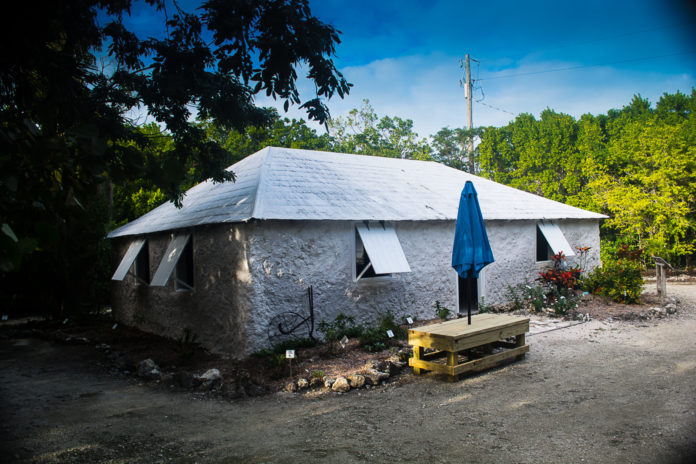The oldest house in the Florida Keys, outside of Key West, takes a bit of effort to find. It is found in the woods of Marathon, on Key Vaca, at Crane Point Hammock.
The house was built by George Adderley, who, circa 1890, at 20 years of age, left his life in the Bahamas behind and moved to the Florida Keys. Before building his house on Key Vaca, he lived on what has been described as Matecumbe Key, which probably indicates Upper Matecumbe Key, where the small farming community of Matecumbe was developing. He married his wife, Olivia, in 1896.
In 1902, he and his wife moved to Key Vaca, settling in a virgin sub-tropical hammock on the gulf side of the island where, the following year, he purchased 32.25 acres for $100. Adderley would clear land and begin to build his house, a rectangular masonry vernacular structure with a hip roof covered in pressed tin. A homemade form of concrete called tabby held the masonry together. The mixture was created by burning shells, in this case, conch shells, to extract lime. The lime was then mixed with water, sand, ash and crushed shells until the sticky “concrete” paste was formed. The house, built circa 1906, resembled a typical rural Bahamian home.
Around George and Olivia and their adopted daughter, Louisa Smith, the small black community of Adderley Town grew. Five homes were built in the area, though Adderley’s is the only surviving structure. The community worked as fishermen, spongers and charcoal makers.
When making charcoal, buttonwood was the preferred tree. The late Florida historian Charleon Tebeau described the process: “Great cone-shaped heaps of neatly stacked wood were built up sometimes containing as much as ten cords for a single burning. This was then covered with grass and sand to make it airtight except for a vent at the top. Enough openings were made around the bottom to fire the wood and burn it so as to drive out the volatile gasses and leave charcoal. A cord of wood produced ten bags of charcoal for which there was a ready market.”
By the time Adderley had built his home, the Key West Extension of Henry Flagler’s East Coast Railway was making tracks for Key West. Although the train would not reach Key West until 1912, by 1908, daily rail service had been established between Miami and the temporary terminus at Knights Key, three miles away at what is today considered the beginning of the Seven Mile Bridge. The right-of-way ran through Adderley’s property and, in exchange for him selling the land required for the right-of-way, the F.E.C. agreed to create a stop at Adderley Town.
The only railroad depot located on Key Vaca was the Marathon Station, once found in the vicinity of what is 33rd Street today. At Adderley Town, the railroad built a platform and created a flag stop. Once a week, if, as the train was roaring across Key Vaca and the engineer saw the flag raised at the Adderley Town platform, he would stop.
Among the residents of Adderley Town, according to the 1910 U.S. Census, was the Adderley family, and Joseph and Margret Curry and their adopted son Joseph Butler. Joseph Rigby lived on nearby Old Rachel Key with the community’s lone non-Bahamian family, David and Janet Freeman, from South Carolina. Three men were identified living in a schooner anchored off Old Rachel Key.
George and Olivia Adderley would sell their property to Francis and Mary Crane in 1949. Olivia died the following year, and her body was laid to rest at the Key West Cemetery. George would be living in Key West, at a home for the blind, when he passed in 1958. He, too, is buried at the island’s cemetery.
The legacy they unknowingly left behind continues to stand and contribute to the rich history of the Florida Keys. The Adderley House is part of the Florida Black History Trail, developed in partnership with the Florida Division of Historical Resources and a group of invested citizens. The subsequent pamphlet they produced provides a microcosm of African American landmarks and legacies.
Among the points of interest presented in the guide is the Adderley House, found at its original location at Crane Point Hammock at 5550 Overseas Highway. In 1992, George’s tabby house of vernacular construction became listed on the National Register of Historic Places, and it is the only house like it still standing in the Florida Keys. When visiting the site, it is possible to step inside and experience the home and an incredible piece of Florida Keys history on a personal level.























